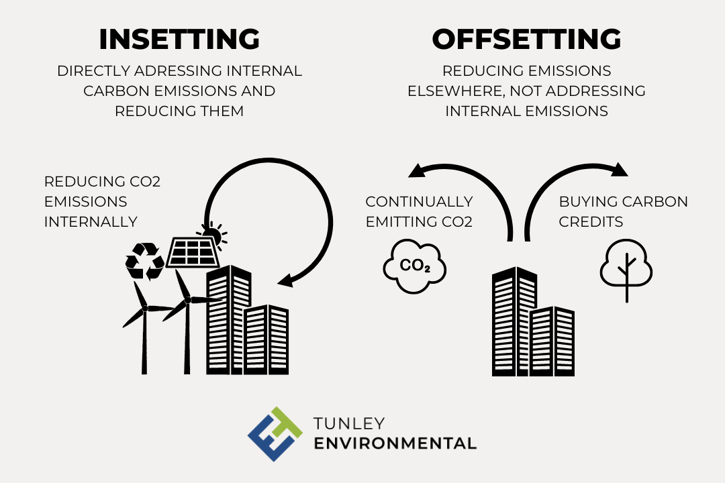What is Carbon Insetting?
Carbon insetting is a sustainable practice aimed at reducing carbon emissions by investing in projects within a company's own supply chain or operations. Unlike carbon offsetting, which involves purchasing carbon credits from external projects to compensate for emissions, carbon insetting focuses on directly addressing and reducing emissions across scopes 1, 2 & 3.
Insetting projects typically involve implementing renewable energy systems, improving energy efficiency, or adopting sustainable practices. By investing in these projects, companies not only reduce their carbon footprint but also contribute to the development of local communities, increasing the efficiency of supply chains and promoting environmental stewardship.

What is Carbon Offsetting?
Carbon offsetting, on the other hand, involves compensating for carbon emissions by funding external projects that reduce greenhouse gas emissions elsewhere. These projects can include initiatives like reforestation, renewable energy projects, or methane capture from landfills. Companies purchase carbon credits equivalent to their emissions, effectively offsetting their carbon footprint.
Carbon offsetting has gained popularity as a means for companies to achieve carbon neutrality or reduce their net emissions. While it provides an avenue for companies to take responsibility for their carbon emissions, it does not directly address or reduce emissions at the source like carbon insetting.
The Key Differences between Carbon Insetting and Carbon Offsetting
The main distinction between carbon insetting and carbon offsetting lies in the approach to carbon reduction. Carbon insetting focuses on internal projects within a company's own supply chain or operations, while carbon offsetting relies on external projects. The World Economic Forum describes insetting as focusing on “doing more good rather than doing less bad within one’s value chain”.
With carbon insetting, companies have more control over the projects they invest in and can directly measure the impact on their emissions. They can implement sustainable practices that not only reduce their carbon footprint but also align with their business objectives. This approach allows companies to build a more sustainable and resilient supply chain while reducing their environmental impact.
In contrast, carbon offsetting provides companies with the option to compensate for their emissions by supporting external projects. While these projects can have a positive impact on reducing global emissions, they may not directly align with a company's core values or supply chain. Additionally, the verification and transparency of carbon offset projects can vary, making it crucial for companies to choose reputable and certified projects.
Why It Is More Important to Inset Carbon
While carbon offsetting has its merits, carbon insetting offers several advantages that make it a more important and sustainable approach to carbon reduction.
-
Direct Emission Reduction
By implementing insetting projects within their own operations, companies have a direct impact on reducing their carbon emissions. This approach allows for targeted emission reductions and ensures that companies actively participate in the transition to a low-carbon economy. Insetting projects serve as a catalyst for sustainable practices and can inspire other companies to follow suit. -
Long-term Sustainability
Carbon insetting promotes long-term sustainability by integrating emission reduction practices into a company's supply chain or operations. By investing in renewable energy systems, energy efficiency improvements, or sustainable agricultural practices, companies can create lasting change. This approach not only reduces emissions but also helps build resilience against future climate risks and fosters sustainable development. -
Local Community Development
Carbon insetting projects often have a positive impact on local communities. By investing in renewable energy infrastructure or sustainable agriculture practices, companies can create employment opportunities and support local economies. This approach goes beyond carbon reduction and contributes to broader social and economic development. -
Alignment with Business Objective
Carbon insetting allows companies to align carbon reduction efforts with their core business objectives. By investing in projects that are directly relevant to their supply chain or operations, companies can achieve a more integrated and strategic approach to sustainability. This alignment enhances the credibility and authenticity of a company's sustainability efforts and can positively impact its reputation.
The Bottom Line
While carbon offsetting has its place in the overall carbon reduction landscape, carbon insetting offers a more impactful and sustainable approach. By focusing on internal projects within a company's own supply chain or operations, carbon insetting provides companies with the opportunity to directly reduce their emissions, promote long-term sustainability, support local communities, and align carbon reduction efforts with their business objectives through a carbon reduction assessment. As we strive for a low-carbon future, it is crucial for companies to prioritise carbon insetting as a means to effectively combat climate change and create a more sustainable world.
JOIN US IN EMBRACING CARBON INSETTING AS A POWERFUL TO REDUCE EMISSIONS AND CREATE A SUSTAINABLE FUTURE.
By investing in carbon insetting, we can drive meaningful change, promote sustainability, and combat climate change. Start your carbon insetting journey today!



